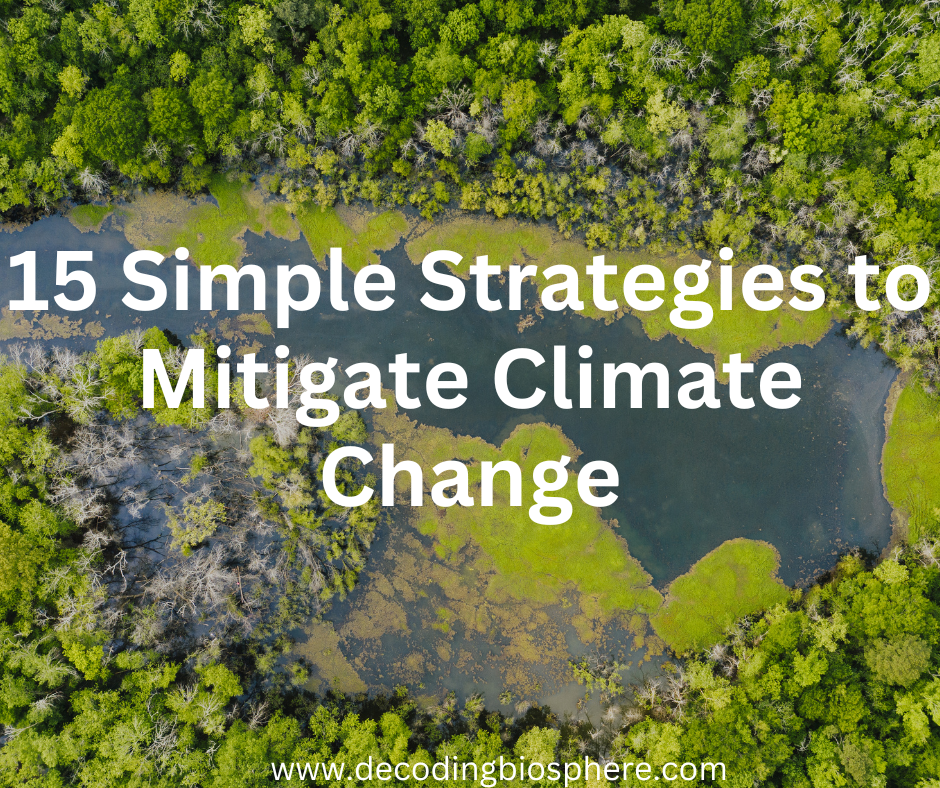Climate change is a pressing issue that affects us all. From rising temperatures to extreme weather events, its impacts are undeniable. But amidst the challenges, there is hope. By taking action, both big and small, we can mitigate climate change and build a more sustainable future for our planet. In this article, we’ll explore 15 simple strategies that individuals, communities, and governments can adopt to combat climate change.
1. Embrace Renewable Energy
Transitioning to renewable energy sources such as solar, wind, and hydropower is crucial for reducing greenhouse gas emissions. Installing solar panels on rooftops, supporting wind energy projects, and investing in community-based renewable energy initiatives are effective ways to harness clean, sustainable energy.
2. Energy Efficiency Improvements
Improving energy efficiency in homes, businesses, and industries can significantly reduce energy consumption and carbon emissions. Simple measures such as upgrading to energy-efficient appliances, installing LED light bulbs, and properly insulating buildings can lead to substantial energy savings and lower carbon footprints.
3. Sustainable Transportation
Promoting sustainable transportation options such as walking, cycling, carpooling, and using public transit can help reduce reliance on fossil fuels and decrease emissions from vehicles. Investing in infrastructure for cycling and walking, expanding public transit networks, and incentivizing the use of electric vehicles are key strategies for achieving greener, cleaner transportation systems.
4. Reforestation and Afforestation
Planting trees and restoring degraded forests play a vital role in sequestering carbon dioxide from the atmosphere and mitigating climate change. Community tree-planting initiatives, reforestation projects, and agroforestry practices can help enhance carbon sinks, restore ecosystems, and enhance biodiversity.
5. Sustainable Agriculture Practices
Adopting sustainable agriculture practices such as conservation tillage, crop rotation, and agroecology can reduce greenhouse gas emissions from agricultural activities while enhancing soil health and resilience. Supporting small-scale farmers, promoting organic farming methods, and reducing food waste are essential for building a more sustainable food system.
6. Waste Reduction and Recycling
Reducing waste generation, recycling materials, and composting organic waste can help minimize methane emissions from landfills and conserve resources. Implementing waste separation programs, promoting recycling initiatives, and supporting circular economy models are effective strategies for reducing the environmental impact of waste disposal.
7. Energy-Efficient Buildings
Designing and constructing energy-efficient buildings that utilize passive heating and cooling techniques, efficient insulation, and renewable energy systems can significantly reduce energy consumption and carbon emissions. Retrofitting existing buildings with energy-saving technologies and implementing green building standards are essential for promoting sustainable urban development.
8. Climate-Friendly Diet Choices
Making climate-friendly diet choices such as reducing meat consumption, eating more plant-based foods, and choosing sustainably sourced products can help reduce the environmental impact of food production and mitigate greenhouse gas emissions. Embracing vegetarian or vegan diets, supporting local and organic food producers, and reducing food waste can contribute to a more sustainable food system.
9. Water Conservation
Conserving water resources through efficient water use, rainwater harvesting, and water-saving technologies is essential for addressing water scarcity and reducing energy consumption associated with water treatment and distribution. Implementing water-saving measures in households, industries, and agriculture can help mitigate the impacts of climate change on water availability and quality.
10. Sustainable Forest Management
Promoting sustainable forest management practices such as reduced-impact logging, forest restoration, and community-based conservation initiatives can help protect forests, enhance carbon sequestration, and support local livelihoods. Strengthening forest governance, combating illegal logging, and promoting sustainable timber certification are essential for preserving forest ecosystems and mitigating climate change.
11. Green Infrastructure
Investing in green infrastructure such as green roofs, permeable pavements, and urban green spaces can help mitigate the urban heat island effect, reduce stormwater runoff, and enhance biodiversity in cities. Incorporating nature-based solutions into urban planning and design can contribute to climate resilience and create healthier, more livable communities.
12. Carbon Pricing and Financial Incentives
Implementing carbon pricing mechanisms such as carbon taxes or cap-and-trade systems can create financial incentives for reducing greenhouse gas emissions and transitioning to low-carbon technologies. Providing subsidies, tax incentives, and financial support for renewable energy projects, energy efficiency improvements, and sustainable practices can accelerate the transition to a low-carbon economy.
13. Climate Education and Awareness
Raising awareness about climate change and its impacts through education, outreach, and public engagement is essential for mobilizing action and building support for climate mitigation efforts. Integrating climate change education into school curricula, promoting climate literacy, and fostering community dialogue can empower individuals and communities to take meaningful action to address climate change.
14. International Cooperation and Collaboration
Fostering international cooperation and collaboration on climate action is crucial for addressing the global nature of climate change and achieving ambitious emission reduction targets. Participating in international climate agreements, sharing best practices, and supporting developing countries in their efforts to mitigate and adapt to climate change are essential for achieving collective climate goals.
15. Community Resilience and Adaptation
Building community resilience and adaptive capacity to climate change impacts such as extreme weather events, sea-level rise, and temperature extremes is essential for safeguarding vulnerable populations and ecosystems. Investing in climate-resilient infrastructure, early warning systems, and disaster preparedness measures can help communities adapt to climate change and minimize its adverse effects.

